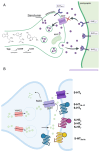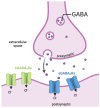Unveiling GABA and Serotonin Interactions During Neurodevelopment to Re-Open Adult Critical Periods for Neuropsychiatric Disorders
- PMID: 40564972
- PMCID: PMC12192930
- DOI: 10.3390/ijms26125508
Unveiling GABA and Serotonin Interactions During Neurodevelopment to Re-Open Adult Critical Periods for Neuropsychiatric Disorders
Abstract
The mature brain is the result of a complex neurodevelopmental process resulting from interweaved mechanisms and involving early genetic and microenvironmental factors shaped by patterns of spontaneous electrical activity. During postnatal development, the immature brain undergoes experience-dependent structural and functional shaping and modifications during critical period (CP) time windows to achieve the full maturation of brain functions. Plasticity is higher during neurodevelopmental CP windows and is limited in the adult brain, including during neuropsychiatric disorders. Notably, the neurotransmitters γ-aminobutyric acid (GABA) and serotonin are two fundamental players controlling and modulating, respectively, brain plasticity in the developing and adult brain. Therefore, acquiring insights into the roles played by GABA and serotonin in regulating CP plasticity might hold potential for pharmacologically re-opening CP windows in adult life, with the aim of providing therapeutic intervention for neurological and neuropsychiatric disorders.
Keywords: GABA; adult plasticity; cognition; neurodevelopment; neuropsychiatric disorders; plasticity; serotonin.
Conflict of interest statement
The authors declare no conflicts of interest.
Figures




References
Publication types
MeSH terms
Substances
Grants and funding
LinkOut - more resources
Full Text Sources
Medical
Miscellaneous

